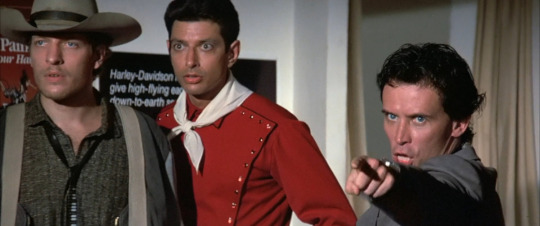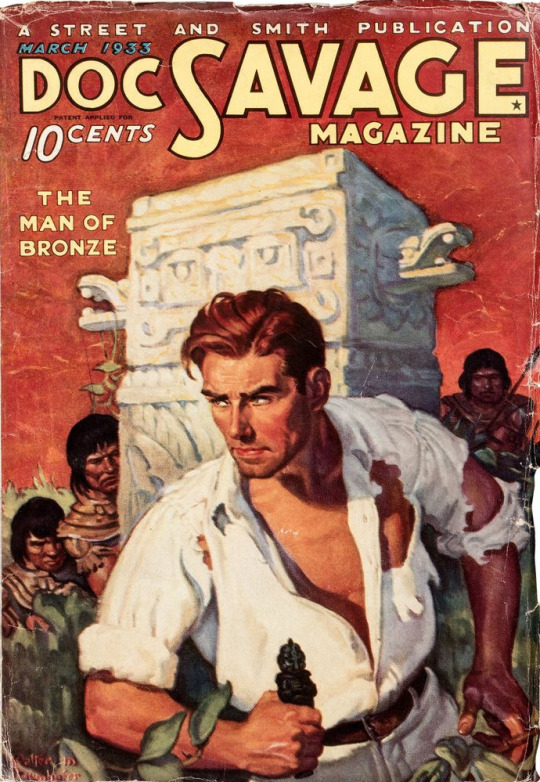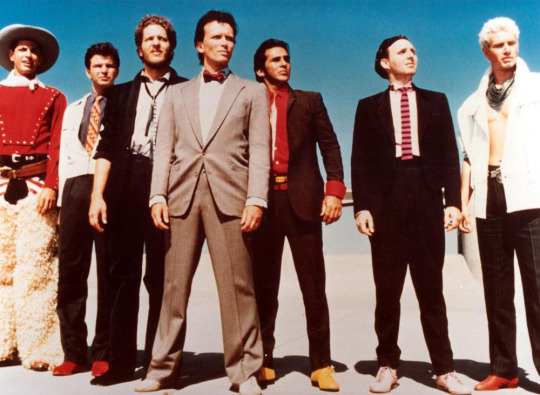#Pepe Serna
Explore tagged Tumblr posts
Text














Oigan, everybody, vengan, vengan. Come, come, come, come, come. Oigan. Vengan, vengan. Is everybody here? Okay. Jorgito's boyfriend is a bisexual, and he's letting us ask questions.
#with love#with love amazon#tvedit#lgbtedit#lgbtgifs#vincent rodriguez iii#renee victor#pepe serna#mark indelicato#constance marie#jorge diaz jr#henry cruz#marta delgado#luis delgado#beatriz diaz#mygraphics#with love show
93 notes
·
View notes
Text

August 1984. This won't change anyone's feelings about cult movie perennial THE ADVENTURES OF BUCKAROO BANZAI: ACROSS THE EIGHTH DIMENSION one way or the other, but if you're wondering what the hell the deal is supposed to be with Buckaroo Banzai and his team, the answer is, "It's an obvious pastiche of the pulp hero Doc Savage."
Launched in 1933, Doc Savage was one of the leading adventure heroes of the pulp magazines. Doc (whose full name was Clark Savage Jr.) was scientifically trained from childhood to the peak of human perfection, singularly adept in everything from mechanical engineering to medicine to martial arts. He had a secret headquarters called the Fortress of Solitude and a whole array of specially designed vehicles and equipment, but he was also a public figure, with offices in the Empire State Building. Doc had a team of eccentric, highly specialized aides — Monk Mayfair, Ham Brooks, Renny Renwick, Long Tom Roberts, and Johnny Littlejohn — who each had a particular skill and a couple of distinctive personality traits (for instance, Monk was a skilled industrial chemist, but also an "ape-like" brute with a ferocious temper). They were sometimes aided by Doc's cousin, Pat Savage, who was almost as capable as Doc, although he tried to keep her out of the fray because she was (gasp) a girl.

This was a fairly common pattern for pulp heroes. For instance, the pulp version of the Shadow (who was distinctly different from the radio incarnation) relied on a whole network of agents, some appearing only once or twice, some recurring across many of his published adventures. From a narrative standpoint, the agents and assistants had two principal purposes: The first was to offset the rather overpowered heroes — pulp heroes didn't necessarily have superhuman powers, but even those who didn't tended to be preternaturally skilled at nearly everything, so it was convenient to limit their direct involvement in an adventure to crucial moments, and let the assistants (who could be much more fallible) do much of the legwork. The second object was to beef up the characterization. Doc Savage was morally irreproachable as well as absurdly multi-talented, so there wasn't a lot to be done with him character-wise, while maintaining the mystique of a character like the Shadow required him to remain a fairly closed book.
Although the pulp heroes were a huge influence on early comic book superheroes like Superman and Batman, some of these conventions didn't translate well to other media: In a 13-page comic book story or half-hour radio episode, having too many characters was cumbersome (and expensive, where it meant hiring extra actors), and comic book readers normally expected to follow their four-color heroes quite closely, even before the breathless internal monologue became a genre staple. So, Superman inherited Doc Savage's Fortress of Solitude, but not his "Fabulous Five" assistants, while heroes like Batman and Captain America generally stuck with a single sidekick rather than a team of aides. Even the late Doc Savage pulp adventures (which ended in 1949) de-emphasized the assistants to keep the focus more on Doc himself. Ultimately, the pulp heroes didn't really have the right narrative center of gravity for visual media, which is why they've become relatively obscure, despite repeated revival attempts. The 1975 Doc Savage movie with Ron Ely, for instance, was a notorious commercial flop, and elements like Doc's childishly bickering assistants seemed odd and dated, even taking into account the film's nostalgia-bait '30s period setting.
What BUCKAROO BANZAI tried to do was to bring that old pulp hero formula into the modern era with a big infusion of '80s style and humor. Like Doc Savage, Buckaroo is a wildly gifted polymath (in the opening scenes, he rushes from performing brain surgery to test-driving his Jet Car through a mountain), so famous and important a personage that he puts the president of the United States on hold, and he surrounds himself with an array of brilliant, eccentric aides with silly nicknames who play in his rock band when they're not fighting crime or doing advanced scientific experiments.

Alas, judging by the poor box office returns, general audiences were no more amenable to the '80s version of this formula than they had been to DOC SAVAGE: MAN OF BRONZE nine years earlier, even with the 1984 film's extraordinary cast and memorably witty dialogue. Granted, even many of the movie's most diehard fans are baffled by the convoluted plot — a crucial expository scene where the leader of the Black Lectroids (Rosalind Cash) explains much of what's going on is nigh-incomprehensible without subtitles or closed captioning — but beyond that, THE ADVENTURES OF BUCKAROO BANZAI is essentially an extended riff on a particular slice of pop culture that had long since dropped out of the public consciousness, which is both part of its charm and also its commercial undoing, at least as mainstream entertainment.
(Also, if you're wondering, yes, the TOM STRONG series by Alan Moore and Chris Sprouse is also an obvious Doc Savage pastiche, although at least some of its plot and character concepts were probably retoolings of unused ideas from Moore's earlier Maximum Press/Awesome Comics SUPREME series, which was an extended pastiche of the pre-Crisis Superman.)
#movies#buckaroo banzai#the adventures of buckaroo banzai across the eighth dimension#w.d. richter#peter weller#jeff goldblum#clancy brown#doc savage#pulp heroes#street and smith#walter m baumhofer#the shadow#michael santoro#pepe serna#billy vera#lewis smith#one of the amusing things about the jeff goldblum character#is that his eccentricity clearly precedes his involvement with buckaroo banzai#he's just a brilliant neurosurgeon who's been looking for a chance#to wear his roy rogers outfit and fight crime
126 notes
·
View notes
Text

7 notes
·
View notes
Text





Group Marriage (1972/1973) Stephanie Rothman
June 30th 2024
#group marriage#1972#1973#stephanie rothman#aimee eccles#Aimée Eccles#solomon sturges#jeff pomerantz#victoria vetri#zack taylor#claudia jennings#bill striglos#pepe serna#norman bartold#john mcmurtry#jayne kennedy
11 notes
·
View notes
Text



John Davis Chandler, Robert F. Lyons, Susan Tyrrell & Pepe Serna Shoot Out Dir: Henry Hathaway
#<3#shoot out#henry hathaway#john davis chandler#mon trésor#robert f. lyons#susan tyrrell#pepe serna#my gifs#my edit#i've never been more jealous of a horse#look at him#that's my babygirl#my ray of sunshine#love of my life
3 notes
·
View notes
Text

Bad movie I have The Adventures of Buckaroo Banzai Across the Eighth Dimension 1984
#The Adventures of Buckaroo Banzai Across the Eighth Dimension#Peter Weller#John Lithgow#Ellen Barkin#Jeff Goldblum#Christopher Lloyd#Lewis Smith#Rosalind Cash#Robert Ito#Pepe Serna#Ronald Lacey#Matt Clark#Clancy Brown#William Traylor#Carl Lumbly#Vincent Schiavelli#Dan Hedaya#Mariclare Costello#Bill Henderson#Damon Hines#Billy Vera#Laura Harrington#Michael Santoro#Jonathan Banks#Robert Gray#Gary Bisig#Kent Perkins#John Ashton#Ken Magee#James Keane
5 notes
·
View notes
Text

John Davis Chandler, Robert F. Lyons & Pepe Serna Shoot Out Dir: Henry Hathaway
#<3#shoot out#henry hathaway#john davis chandler#mon trésor#robert f. lyons#pepe serna#my gif#my edit#conradrasputin#look at the baby
3 notes
·
View notes
Text

John Davis Chandler, Pepe Serna & Robert F. Lyons Shoot Out Dir: Henry Hathaway
1 note
·
View note
Text

youtube
0 notes
Text
Still one of the best indie movies i have ever watched..
I've made my mom watch it. And, normally, she never enjoys movies with subtitles. She is the typical german Person complaining about Dubs. (This is a crazy situation here.)
But this movie was something else. She watched it from start to finish and loved it. She was so proud, she called my bother after watching the movie and told him everything. The whole Story of the movie!





Kazuki Kitamura as the 'man from reno'
#kazuki kitamura#man from reno#japan#japanese actor#movie#ayako fujitani#japanese actress#pepe serna#film noir#neon noir#academia#academia aesthetic#kitamura kazuki#北村 一輝#yakuza#the dude played kiryu
15 notes
·
View notes
Text
Generation of 27
The Generation of '27 (Spanish: Generación del 27) was an influential group of poets that arose in Spanish literary circles between 1923 and 1927, essentially out of a shared desire to experience and work with avant-garde forms of art and poetry. Their first formal meeting took place in Seville in 1927 to mark the 300th anniversary of the death of the baroque poet Luis de Góngora. Writers and intellectuals paid homage at the Ateneo de Sevilla, which retrospectively became the foundational act of the movement.
Terminology:
The Generation of '27 has also been called, with lesser success, "Generation of the Dictatorship", "Generation of the Republic", "Generation Guillén-Lorca" (Guillén being its oldest author and Lorca its youngest), "Generation of 1925" (average publishing date of the first book of each author), "Generation of Avant-Gardes", "Generation of Friendship", etc. According to Petersen, "generation group" or a "constellation" are better terms which are not so much historically restricted as "generation".
Aesthetic style:
The Generation of '27 cannot be neatly categorized stylistically because of the wide variety of genres and styles cultivated by its members. Some members, such as Jorge Guillén, wrote in a style that has been loosely called jubilant and joyous and celebrated the instant, others, such as Rafael Alberti, underwent a poetic evolution that led him from youthful poetry of a more romantic vein to later politically-engaged verses.
The group tried to bridge the gap between Spanish popular culture and folklore, classical literary tradition and European avant-gardes. It evolved from pure poetry, which emphasized music in poetry, in the vein of Baudelaire, to Futurism, Cubism, Ultraistand Creationism, to become influenced by Surrealism and finally to disperse in interior and exterior exile following the Civil Warand World War II, which are sometimes gathered by historians under the term of the "European Civil War". The Generation of '27 made a frequent use of visionary images, free verses and the so-called impure poetry, supported by Pablo Neruda.
Members:
In a restrictive sense, the Generation of '27 refers to ten authors, Jorge Guillén, Pedro Salinas, Rafael Alberti, Federico García Lorca, Dámaso Alonso, Gerardo Diego, Luis Cernuda, Vicente Aleixandre, Manuel Altolaguirre and Emilio Prados. However, many others were in their orbit, some older authors such as Fernando Villalón, José Moreno Villa or León Felipe, and other younger authors such as Miguel Hernández. Others have been forgotten by the critics, such as Juan Larrea, Pepe Alameda, Mauricio Bacarisse, Juan José Domenchina, José María Hinojosa, José Bergamín or Juan Gil-Albert. There is also the "Other generation of '27", a term coined by José López Rubio, formed by himself and humorist disciples of Ramón Gómez de la Serna, including: Enrique Jardiel Poncela, Edgar Neville, Miguel Mihura and Antonio de Lara, "Tono", writers who would integrate after the Civil War (1936–39) the editing board of La Codorniz.
Furthermore, the Generation of '27, as clearly reflected in the literary press of the period, was not exclusively restricted to poets, including artists such as Luis Buñuel, the caricaturist K-Hito, the surrealist painters Salvador Dalí and Óscar Domínguez, the painter and sculptor Maruja Mallo, as well as Benjamín Palencia, Gregorio Prieto, Manuel Ángeles Ortiz and Gabriel García Maroto, the toreros Ignacio Sánchez Mejías and Jesús Bal y Gay, musicologists and composers belonging to the Group of Eight, including Bal y Gay, Ernesto Halffter and his brother Rodolfo Halffter, Juan José Mantecón, Julián Bautista, Fernando Remacha, Rosa García Ascot, Salvador Bacarisse and Gustavo Pittaluga. There was also the Catalan Group who presented themselves in 1931 under the name of Grupo de Artistas Catalanes Independientes, including Roberto Gerhard, Baltasar Samper, Manuel Blancafort, Ricard Lamote de Grignon, Eduardo Toldrá and Federico Mompou.
Finally, not all literary works were written in Spanish: Salvador Dalí and Óscar Domínguez also wrote in French. Foreigners such as the Chilean poets Pablo Neruda and Vicente Huidobro, the Argentine writer Jorge Luis Borges, and the Franco-Spanish painter Francis Picabia also shared much with the aesthetics of the Generation of '27.
The Generation of '27 was not exclusively located in Madrid, but rather deployed itself in a geographical constellation which maintained links together. The most important nuclei were in Sevilla, around the Mediodía review, Tenerife around the Gaceta de Arte, and Málaga around the Litoral review. Others members resided in Galicia, Catalonia and Valladolid.
The Tendencies of '27:
The name "Generation of 1927" identifies poets that emerged around 1927, the 300th anniversary of the death of the Baroque poet Luis de Góngora y Argote to whom the poets paid homage. It sparked a brief flash of neo-Gongorism by outstanding poets like Rafael Alberti, Vicente Aleixandre, Dámaso Alonso, Luis Cernuda, Gerardo Diego and Federico García Lorca.
Spanish Civil War aftermath:
The Spanish Civil War ended the movement: García Lorca was murdered, Miguel Hernandez died in jail and other writers (Rafael Alberti, Jose Bergamin, León Felipe, Luis Cernuda, Pedro Salinas, Juan Ramón Jiménez, Bacarisse) were forced into exile, although virtually all kept writing and publishing late throughout the 20th century.
Dámaso Alonso and Gerardo Diego were among those who reluctantly remained in Spain after the Francoists won and more or less reached agreements with the new authoritarian and traditionalist regime or even openly supported it, in the case of Diego. They evolved a lot, combining tradition and avant-garde, and mixing many different themes, from toreo to music to religious and existentialist disquiets, landscapes, etc. Others, such as Vicente Aleixandre and Juan Gil-Albert, simply ignored the new regime, taking the path of interior exile and guiding a new generation of poets.
However, for many Spaniards the harsh reality of Francoist Spain and its reactionary nature meant that the cerebral and aesthetic verses of the Generation of '27 did not connect with what was truly happening, a task that was handled more capably by the poets of the Generation of '50 and the social poets.
Statue:
A statue dedicated to the Generation 27 Poets is now in Seville in Spain. The inscription on the monument translates as 'Seville The poets of the Generation of 27'
List of members[edit]
Rafael Alberti (1902–1999)
Vicente Aleixandre (1898–1984)
Amado Alonso (1897–1952)
Dámaso Alonso (1898–1990)
Manuel Altolaguirre (1905–1959)
Francisco Ayala (1906–2009)
Mauricio Bacarisse (1895–1931)
José Bello (1904–2008)
Rogelio Buendía (1891–1969)
Alejandro Casona (1903–1965)
Juan Cazador (1899–1956)
Luis Cernuda (1902–1963)
Juan Chabás (1900–1954)
Ernestina de Champourcín (1905–1999)
Gerardo Diego (1896–1987)
Juan José Domenchina (1898–1959)
Antonio Espina (1894–1972)
Agustín Espinosa (1897–1939)
León Felipe (1884–1968)
Agustín de Foxá (1903–1959)
Pedro García Cabrera (1905–1981)
Federico García Lorca (1898–1936)
Pedro Garfias (1901–1967)
Juan Gil-Albert (1904–1994)
Ernesto Giménez Caballero (1899–1988)
Jorge Guillén (1893–1984)
Emeterio Gutiérrez Albelo (1905–1937)
Miguel Hernández (1910–1942)
José María Hinojosa (1904–1936)
Enrique Jardiel Poncela (1901–1952)
Rafael Laffón (1895–1978)
Antonio de Lara (1896–1978)
Juan Larrea (1895–1980)
José López Rubio (1903–1996)
José María Luelmo (1904–1991)
Francisco Madrid (1900–1952)
Paulino Masip (1899–1963)
Concha Méndez (1898–1986)
Miguel Mihura (1905–1977)
Edgar Neville (1899–1967)
Antonio Oliver (1903–1968)
Pedro Pérez-Clotet (1902–1966)
Rafael Porlán (1899–1945)
Emilio Prados (1899–1962)
Joaquín Romero Murube (1904–1969)
Pedro Salinas (1891–1951)
Guillermo de Torre (1900–1971)
José María Souvirón (1904–1973)
Miguel Valdivieso (1897–1966)
Fernando Villalón (1881–1930)
13 notes
·
View notes
Text

Karen Carlson in The Student Nurses (Stephanie Rothman, 1970)
Cast: Elaine Giftos, Karen Carlson, Brioni Farrell, Barbara Leigh, Reni Santoni, Richard Rust, Lawrence P. Casey, Darrell Larson, Paul Camen, Richard Stahl, Katherine MacGregor, Pepe Serna, John Pearce, Mario Aniov, Ron Gans. Screenplay: Don Spencer, Stephanie Rothman, Charles S. Swartz. Cinematography: Stevan Larner. Art direction: David Nichols. Film editing: Stephen Judson. Music: Roger Dollarhide, Clancy B. Grass III.
Yes, the dialogue is clunky, the acting is amateurish, and the nudity is gratuitous, but The Student Nurses has a heart. That heart is Stephanie Rothman's. Working for the great quickie producer Roger Corman, she devised a story that would be exploitative enough for audiences wanting a little sex and yet give her the opportunity to deal with hot-button issues like drugs, abortion, and social protest. So she came up with a quartet of student nurses and devised situations in which they might encounter one or more of those issues, at the same time making a case for female independence and strength. True, they're nubile and somewhat randy women with no hesitation about taking off their tops, and the men they encounter are far from ideal. Phred (Karen Carlson) hooks up with a young OB/GYN named Jim (Lawrence P. Casey), Priscilla meets a drug-selling biker named Les (Richard Rust) at a love-in, Lynn (Brioni Farrell) falls for a Chicano activist, and Sharon (Elaine Giftos) befriends an embittered young man named Greg (Darrell Larson) who is dying of cystic fibrosis. If The Student Nurses had a real budget and some sharper dialogue and the four nurses had been played by actors like Jane Fonda, Natalie Wood, Katharine Ross, and Faye Dunaway, it might be remembered as a minor classic of its day.
1 note
·
View note
Text
0 notes
Text
PEPE SERNA LIFE IS ART | CLIP con Eva Longoria
https://www.instagram.com/p/C3oO9_NNpzR/ Con más de 100 películas y créditos televisivos en su haber, su interpretación más conocida llegó de la mano de Scarface, donde compartió pantalla con Al Pacino y dio vida al icónico personaje de Ángel Fernández, cuya muerte se convirtió en una de las más memorables de la historia del cine. Nacido en Corpus Christi (Texas) en 1944, Serna construyó su…

View On WordPress
1 note
·
View note
Text


CALIFICACIÓN PERSONAL: 6 / 10
Título Original: Flamin' Hot
Año: 2023
Duración: 98 min
País: Estados Unidos
Dirección: Eva Longoria
Guion: Linda Yvette Chávez, Lewis Colick. Biografía sobre: Richard Montañez
Música: Marcelo Zarvos
Fotografía: Federico Cantini
Reparto: Jesse Garcia, Annie Gonzalez, Tony Shalhoub, Dennis Haysbert, Matt Walsh, Emilio Rivera, Pepe Serna, Jimmy Gonzales, Bobby Soto, Vanessa Martinez
Productora: Fox Searchlight, Franklin Entertainment. Distribuidora: Hulu
Género: Biography; History; Drama
TRAILER:
dailymotion
0 notes
Text





Kazuki Kitamura as the 'man from reno'
#kazuki kitamura#man from reno#japan#japanese actor#movie#ayako fujitani#japanese actress#pepe serna#film noir#neon noir#academia#academia aesthetic#kitamura kazuki#北村 一輝#yakuza#the dude played kiryu
15 notes
·
View notes